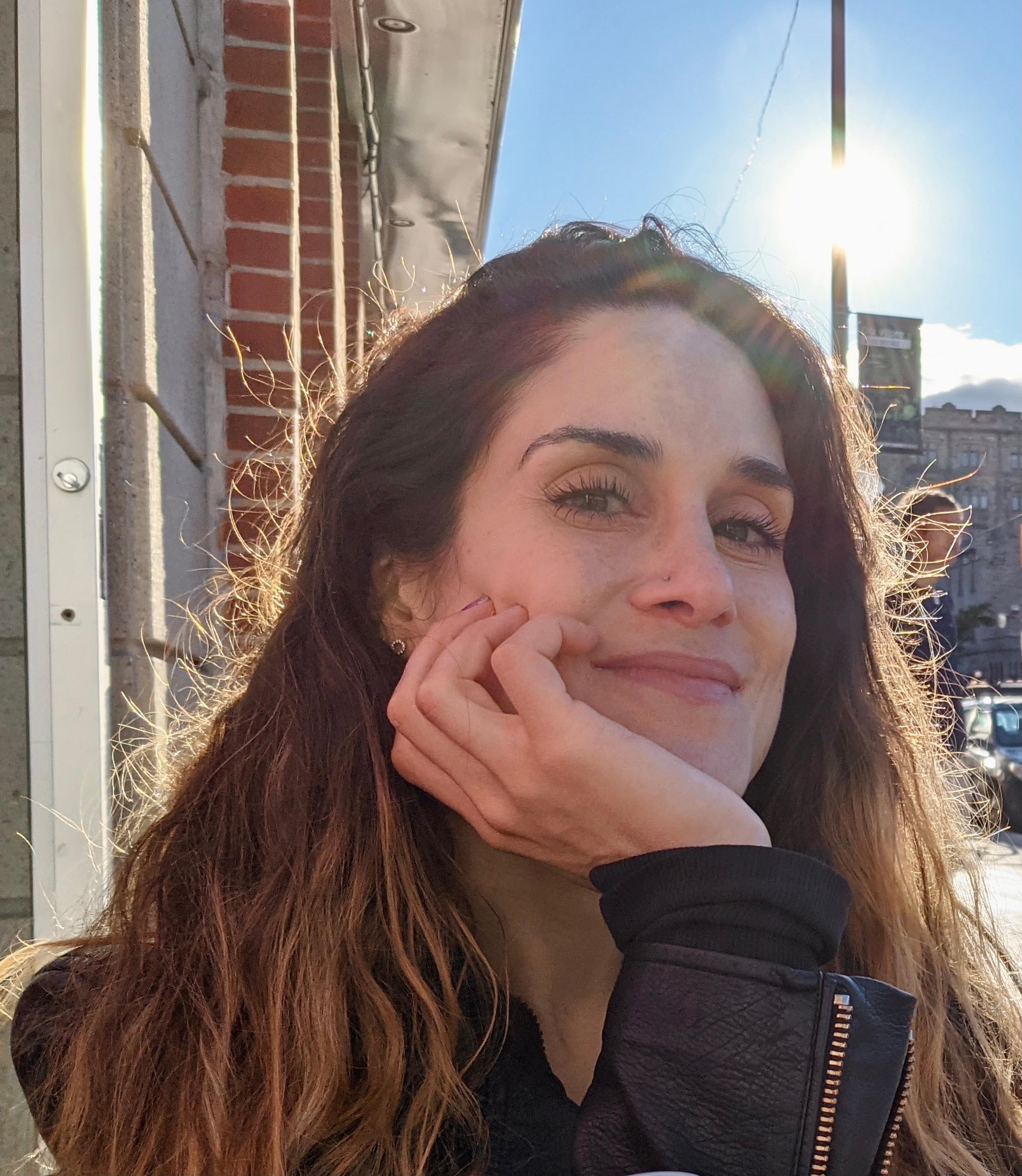


Given the amount of appearance-focused messages that bombard us daily from every direction, you’d be hard pressed to find someone who feels completely neutral about their body. Advertisers and influencers force us to focus on our “problem areas,” heavily filtered social media photos lead us to compare our bodies to ones that don’t even really exist, and tired diet culture myths trick us into viewing our bodies as objects that require constant monitoring and modification. With that amount of noise constantly ringing in our ears, the phrase “body neutrality” can feel like an oxymoron.
And yet, body neutrality is actually an achievable approach that not only helps cancel out the constant deluge of appearance-focused messaging, but can also power eating disorder recovery. Equip Senior Program Development Lead Ally Duvall says body neutrality was instrumental in helping her heal from her eating disorder. “I spent so many years wanting to distance myself from my body—begging for change, thinness, and confidence,” she says. “Body neutrality gave me the permission to lay down my judgments and hatred, without the pressure to pick up positivity in its place.”
So what is body neutrality, how does it differ from body positivity and other anti-diet culture movements, and can it really help those in eating disorder treatment move toward full recovery? Here’s everything you need to know about body neutrality and its potential role in recovery and beyond.
Defining body neutrality
When you hear the phrase “body neutrality,” you might assume that it means cultivating complete indifference to how your body looks. That’s decidedly not the definition of body neutrality, which has more to do with appreciating what our bodies do versus how they look.
“I view body neutrality as the midpoint between self-defamation and radical self-love,” says Equip Clinical Partnerships Representative and registered dietitian Christina Fattore, MS, RDN. “It’s the idea that we can appreciate and respect our bodies without needing to unequivocally love everything about ourselves, especially on days when that may seem close to impossible. Body neutrality shifts the focus away from our bodies as our defining feature, and instead frames our bodies as a small part of who we are as a whole.”
While the phrase itself seems to have originated around 2015, it picked up popularity when eating disorder specialists online started using “body neutrality” as a paradigm for building a healthier relationship to food, exercise, and body image. Anne Poirier, a certified intuitive eating counselor and eating disorder specialist, is credited with defining body neutrality as “prioritizing the body’s function and what it can do rather than its appearance.” In her book, The Body Joyful, Poirier underscored the notion that we don’t have to unconditionally love our bodies or hate them; we can simply choose to feel neutral about them.
Licensed psychotherapist Tessa Gordon, LMFT, who has recovered from an eating disorder herself, says she sees body neutrality as a way to let go of any attachment to what our bodies are or aren’t and actively tune out body-focused noise. “It can be a step towards greater body acceptance, but it doesn't have to be,” she says. “Some may be able to love their body; my hope was that I would be able to live in mine. To me, that is body neutrality: when your body is no longer center stage requiring so much focus and attention, and steps into the background or becomes a supporting character, so your life can take center stage.”
Duvall believes that body neutrality lets us meet ourselves on neutral ground, rather than on the roller coaster of diet culture and appearance-obsessed chatter. “When we can see our bodies as the way we exist in this world, we remove the pressures to love, hate, or pick ourselves apart,” she says. “My body is the way I give my husband a hug and feel the cool pool water on my skin. It’s my way of traveling and how I experience cotton-candy sunsets.” This shift allows us to view our bodies as a means for experiencing life, rather than an object that’s meant to look a certain way.

How does body neutrality relate to body positivity, body liberation, and body acceptance?
Today, there are (thankfully!) so many approaches to navigating how we feel about our bodies that the terminology can get a bit confusing. Between body positivity, body liberation, and body acceptance, it can be difficult to discern the differences between each concept and decide which approach will be most helpful for you.
Because all of these approaches come from a place of rejecting diet culture and redefining your relationship with your body, they all share some qualities, Duvall explains. “Body image theories like body neutrality, body positivity and body liberation exist on a spectrum. There are no clear boundaries on where one begins or ends, however each theory has unique components,” she says.
Body positivity
Body positivity is perhaps the most well known of these approaches, and also the one that’s been around longest: it dates back to the 1960s Fat Acceptance Movement. “Body positivity was built on the work of black, fat body liberationists, who not only focused on loving your body as it is but finding freedom from the oppressive systems we live in,” Duvall explains.
As it exists today (largely in the form of social media hashtags), many people believe body positivity has been adopted and co-opted in ways that diminish its original intent.
Body liberation
In contrast to body positivity, body liberation continues to be considered a form of “freedom from social and political systems of oppression that designate certain bodies as more worthy, healthy, and desirable than others,” and is closely tied to social justice issues. “Body liberation is a thread that can flow in any of these theories as it exists to create a world of body freedom—both collectively and individually,” Duvall says. Author Chrissy King dives deeper into this concept and understanding the impacts of racism and diet culture in her book, The Body Liberation Project.
Body acceptance
Body acceptance and body neutrality are similar in that both are centered on simply accepting and remaining objective about the fact that your body is yours, regardless of its weight, shape, size, or state. However, while body acceptance has a slightly positive spin and is more closely tied to the original Fat Acceptance movement, body neutrality is truly that: achieving complete neutrality about your body, not viewing it as good or bad, and learning to focus on its functions rather than its form.
While different theories and approaches may work for different people, Fattore believes body neutrality may feel like the most realistic or achievable goal for some. “Even as an eating disorder dietitian, I would be lying if I said that I am always able to practice body positivity!” she says. “Body neutrality allows us to move away from persistent negative self talk, while still accepting that we may not feel great about ourselves every minute of every day.”
What are the benefits of body neutrality?
According to Fattore, body neutrality empowers people to value themselves on the basis of their internal worth, rather than how they feel about their external appearance at any given time. “It allows us to appreciate the ways our body can act as a vehicle for our successes, rather than as a defining characteristic of them,” she says. “Body neutrality challenges us to permanently shift the conversation away from our appearance, and in doing so helps us reclaim the nuances of our identity.”
In her experience, Gordon has seen many different benefits of body neutrality, including:
- Providing space for you to be where you are in your relationship with your body, no matter what that look like
- Decreasing attachment to how your body looks
- Encouraging gratitude toward your body for existing and being your vessel to carry you through life
- Providing space to acknowledge the ways your body does and doesn't work; holding onto both
- Exposing and encouraging the exploration of social messages, beliefs, systemic oppression, and more
- Offering a more realistic and attainable goal than body positivity
“Body neutrality can be an incredibly powerful stepping stone away from the harmful ways we are taught to engage with our bodies,” Duvall says.
Are there drawbacks to body neutrality?
The biggest potential drawback of body neutrality is its emphasis on the body’s function, which can be problematic for some. “Body neutrality can sometimes be focused on gratitude for abilities—for instance, ‘I’m grateful that my legs get me down the stairs or that my arms can lift my favorite surfboard,’” Duvall says. “While this can be incredibly helpful compared to the previous negative statements you might have said to yourself, relying on ability-based gratitudes still encourages a body relationship with conditions.” In other words, this approach values the body based on its ability to do things; if those abilities changed or went away, so would the body’s value. For some, this not only detracts from the body’s inherent value, but can also be considered ableist.
“Body neutrality can be ableist as it focuses on the body’s functionality and appreciation of what the body can do, and emphasizes ‘not noticing’ your body,” Gordon says. “For those living with chronic pain or disabilities, or those whose bodies may not function in the same way they once did, the privilege to ‘not be aware’ of their body, may not be something they are afforded.”
However, even though some may find this to be a limitation or drawback to body neutrality, there are still ways to expand and apply body neutrality in less function-focused ways. “What if your legs can no longer support you down the stairs or your shoulder injury impacts your ability to carry your surfboard?” Duvall says. “Body neutrality rooted in conditional acceptance can be a sneaky, slippery slope into a harmful relationship with your body. One way to challenge this is to incorporate other types of gratitude alongside the ones based on physical ability. For example, ‘I’m grateful that my presence encourages other people to feel comfortable being themselves’ or ‘I’m grateful that my sense of humor brings myself and others joy.’”
Who is body neutrality good for?
Though everyone’s relationship to their body is unique, many experts consider body neutrality to be a widely applicable and adaptable strategy. “Everyone can benefit from body neutrality!” Fattore says. “I think the concept itself makes self-acceptance seem a lot more attainable, regardless of where someone is at in their self-love journey.”
Gordon emphasizes the fact that a huge benefit of body neutrality is its attainability. “We live in a society that is constantly telling us that our bodies, what we look like, our gender, our size, our shape, our age, our appearance, how we dress—all of this is a measurement of our value and worth,” she says. “The messages that certain bodies hold more value and worth than others are bombarding us 24/7. Asking someone swimming in that to take up body positivity is beyond a Herculean task. Body neutrality offers a life raft to help us begin to get out.”
Duvall agrees with the idea that anyone can adopt and apply the principles of body neutrality—especially for those who have particularly fraught relationships with their body. “Body neutrality may be even more supportive for those who have felt distanced from their body or judgment towards their body, or have identities that are outside of what society considers ‘ideal,’” she says. “Body neutrality can be a way to access a body peace they may have yet to experience.”
How can body neutrality fit into eating disorder recovery?
“The pursuit of body neutrality is so important in the context of eating disorder recovery,” Fattore says. “It is much easier to prioritize healing when we learn to value all the ways our bodies serve us, rather than how they look. Body neutrality allows us to say ‘I may not love what I see in the mirror today, but I am still worthy of nourishment and self-care.’”
Because body positivity may feel unattainable—particularly to those in early recovery—Gordon believes body neutrality could be a more practical approach. “For so many, body positivity can feel akin to toxic positivity,” she says. “Encouraging people struggling with an eating disorder to ‘love their body’ can feel inauthentic, and, as I like to say, ‘floofy.’ Body neutrality can feel like a more realistic first step when coming from a place of such body hatred.”
Duvall adds that while actively working toward body neutrality can take time, the results make it worthwhile—particularly for those who have long struggled with body image issues. “Many people in eating disorder recovery find body neutrality to be the ‘aha’ moment after years of body distress,” she says. “People often expect body image to magically heal itself as someone goes through eating disorder treatment. While body image distress may decrease through treatment, taking active steps to incorporate body neutrality in your recovery can help you build a more neutral foundation to exist on.” (Read more: Do You Address Body Image Issues in Eating Disorder Treatment?)
How to start practicing body neutrality
While the concept of body neutrality may seem like a nice idea on paper, you need to put it into practice to feel its positive effects. “This isn’t something you read about, believe, and immediately feel transformed,” Duvall says. “It requires active reflection, reshaping your automatic thoughts, and finding the places you can begin shifting towards neutrality.”
If you’re not sure where to start, here are some practical tips from Fattore, Gordon, and Duvall to start incorporating body neutrality into your everyday reality:
1. Notice what your body does for you. Start taking stock of how your body enables you to show up in the world (not only physically, but in every other non-aesthetic way). “Focus on all the ways your body allows you to do the things you love,” Fattore says. “Identify the various ways your body serves you each day.” That might mean allowing you to feel the sunshine on your shoulder, to experience a hug from someone you love, to taste your favorite drink, to sit in a comfortable chair and read a book. Mindful movement, like yoga in recovery, can also help with this.
2. Become more mindful of your automatic thoughts. “I always recommend beginning with mindfulness practices—pausing to notice your thoughts and bringing awareness to how your thoughts show up physically and emotionally,” Duvall says. “Then you can explore what it’s like to shift those thoughts into more neutral, acceptance-based messages to your body.”
3. Once you’re more aware of your thoughts, start responding to them. “Maybe you notice your mind veering into judgments on how your legs look in shorts,” Duvall says. “Once you notice that judgment, take a breath and respond with, ‘my body is my way of existing with the world’ or ‘my body’s value is not based on jean shorts.’ This may feel out of place or silly, but saying these responses out loud or writing them down can be helpful in making them stick for future moments.”
4. Wear comfortable clothing and avoid clothes that keep you hyper-focused on your body all day. “It should be a balance between what is physically comfortable, emotionally comfortable, and what keeps you present, even if it doesn’t align with mainstream fashion,” Gordon says. “It’s up to you to find your edge of tolerance—and it may change every day.”
5. Slow down and be present during meals and activities. “Engage with food and exercise mindfully, focusing on what makes you feel good, both physically and mentally,” Fattore advises. “This might look like honoring hunger and fullness cues, incorporating rest days, or basing food choices on what sounds most satisfying in the moment.”
6. Use the mirror as a skill-building tool. “If you’ve been avoiding mirrors and reflective surfaces, the next time you see yourself in a glass door when walking into a building, decide to look at yourself and say, ‘that's me,’ and then look away,” Gordon says. “It's okay if you find yourself caught by judgment or comparison or negative thoughts afterwards. You have to start somewhere. If you find yourself looking and forgetting what to say, you can always try again. That’s why we call this a practice.”
8. Opt out of toxic dialogue. “Make a conscious effort to exclude ‘body talk’ from your conversations—both with yourself and others,” Fattore says.
9. Assess who you follow. “Curate your social media feed!” Gordon says. “Go through and do a cleanse of the profiles you are following that may not be helpful. Then add and follow new accounts that promote body acceptance and body liberation.”
10. Practice self-compassion. “Be patient with yourself,” Fattore says. “It can be difficult to shift the way you think about self-talk and body image—give yourself some grace.”
Duvall also reminds those getting acquainted with body neutrality that we can’t always control what we are thinking or what comes up in tough moments. “Our first thought may be a body judgment or critique, no matter how long we’ve been working on challenging them,” she says. But what matters most is what you want that next thought to be.”
If you’re struggling with body image issues and want to take the first step toward a better relationship with your body, you might benefit from Equip’s free body image program, Explore: Freeform. Learn more and register for the program here.
- “Body Image and Body Liberation.” n.d. Www.uvm.edu. https://www.uvm.edu/health/body-image-and-body-liberation.
- Cowles, Charlotte. 2022. “Can ‘Body Neutrality’ Change the Way You Work Out?” The New York Times, February 2, 2022, sec. Well. https://www.nytimes.com/2022/02/02/well/move/body-neutrality-exercise.html#:~:text=%E2%80%9CBody%20neutrality%20prioritizes%20the%20body%27s.
- “From New York to Instagram: The History of the Body Positivity Movement.” n.d. BBC Bitesize. https://www.bbc.co.uk/bitesize/articles/z2w7dp3#:~:text=Body%20Positivity%20begins%20with%20the.
- Mayo Clinic Staff. 2020. “Mindfulness Exercises.” Mayo Clinic. September 15, 2020. https://www.mayoclinic.org/healthy-lifestyle/consumer-health/in-depth/mindfulness-exercises/art-20046356.
- Konstantinovsky, Michelle. 2022. “How to Reframe the Way You Think about Your Body.” Katie Couric Media. June 13, 2022. https://katiecouric.com/health/what-is-difference-between-body-neutrality-and-positivity/.
- Smith, Leah. 2023. “#Ableism – Center for Disability Rights.” Cdrnys.org. 2023. https://cdrnys.org/blog/uncategorized/ableism/.







